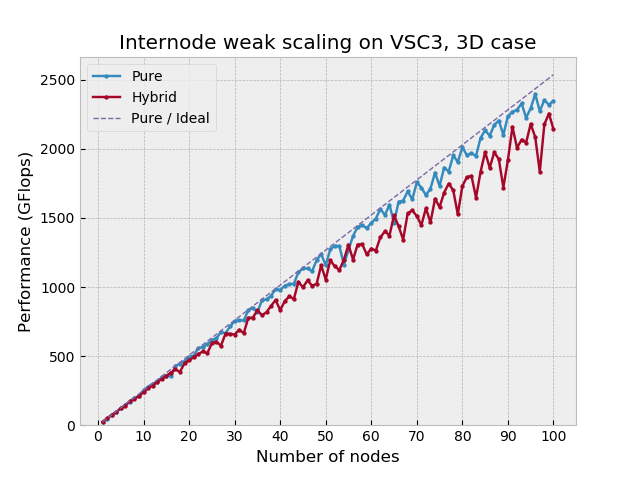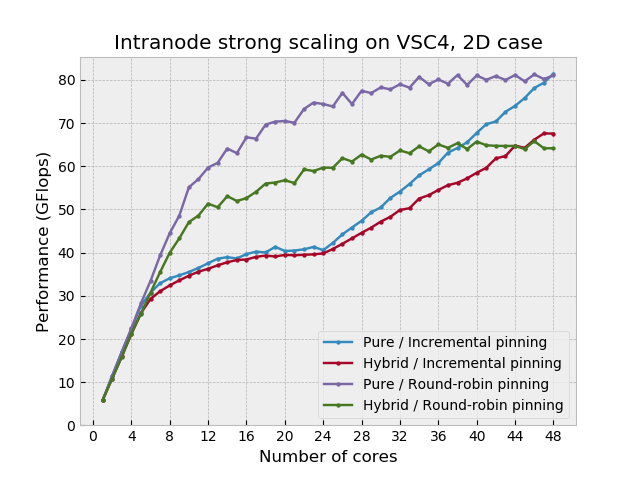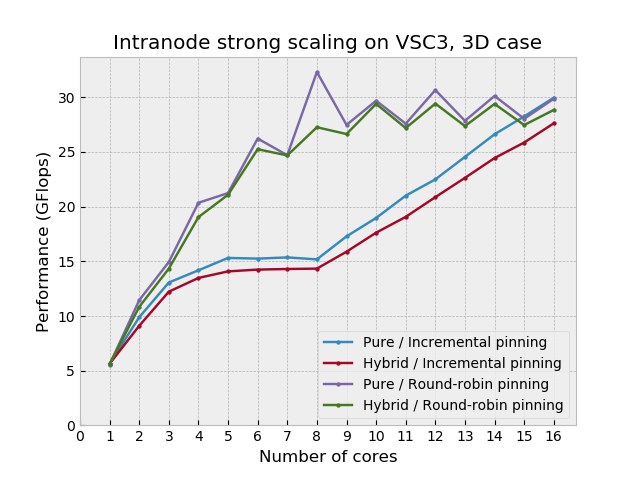This is an MPI parallel implementation of the Jacobi algorithm that is meant to exploit both distributed and shared memory. This does not make use of threads: physical shared memory is managed through MPI one-sided communication features of MPI 3.0.
This project aims to develop a numerical solver of a differential equation using the so called Jacobi algorithm. In layman's terms this simple algorithm iteratively computes a grid of points from a previous one in which every point depends only on its neighbours in the previous grid. If the grid gets splitted in sub-grids (in order to feed different distributed nodes), points at the boundaries will depend on points which are not in the same sub-grid. A data communication among sub-grids is therefore needed; this aspect will mostly characterise the performance of the program. Jacobi is not the best candidate to carry out the numerical job, but here the main goal is to deal with all the issues that come with the distributed + shared memory paradigm and providing an implementation suitable for supercomputers.
Some hybrid programming models combine two different standards like MPI and OpenMP to take advantage of the underlying architecture, however in my project I will pursue different path, using MPI 3.0 shared memory that allows to exploit shared memory by means of the so called one-sided communications feature.
The following is a complete list of command line options that the software supports (3D version):
Usage: jacobi [-m] [-s=DIRECTION] [-n=DIRECTION] [-H=NUM] [-i=FILENAME] [-h]
If no input file is specified, the instance data will be requested in the standard input (stdin).
List of options:
-m, --no-shared-memory
Choose whether to use the shared memory.
-s, --split-direction=DIRECTION
Direction along which to split the workload in the shared memory. Available values are X, Y or Z. Default value is X.
-n, --cart-no-split-direction=DIRECTION
Select along which direction the cartesian topology should be flattened. Available values are X, Y or Z.
-H, --heads-per-shared-region=NUM
Set how many 'head' processes will be instantiated per each physical shared region of memory. Default value is 1.
-i, --input-instance=FILENAME
Input file with domain sizes and parameters one per line: size x, size y, size z, alpha, relaxation, tolerance, max iterations.
-h, --help
Show this help message.
Author : Federico Sossai, federico.sossai@gmail.com
Source code : https://github.com/fsossai/jacobi-hybrid
All benchmarks have been done on partitions of the computing node of the supercomputers kindly provided by Vienna Scientific Cluster. The three clusters used are called VSC3, VSC3plus and VSC4; the latter system is ranked 105 in the TOP500 list at the time of writing (September 2020).
The internode results have been carried out using weak scaling keeping the problem size large in order to avoid non-realistic speedups generally obtained when smaller problems fit into the cache. In the plots, Pure refers to the version that do not consider the shared memory within each node, whereas Hybrid assigns a communicating process per socket and the others works inside its shared memory using MPI One-sided communications therefore, a socket is considered as the shared memory region. The pure version scales almost perfectly but the hybrid one is not able to be on-par. A reason for this may be traced back to implementation details of the MPI One-sided communications.
Process pinning plays a fundamental role in affecting the intranode scaling.
For VSC4 Incremental pinning is obtained setting export I_MPI_PIN_PROCESSOR_LIST=0-47, whereas Round-robin pinning is obtained with export I_MPI_PIN_PROCESSOR_LIST=allcores:grain=1,shift=24.
For VSC3 Incremental pinning is obtained setting export I_MPI_PIN_PROCESSOR_LIST=0-15, whereas Round-robin pinning is obtained with export I_MPI_PIN_PROCESSOR_LIST=allcores:grain=1,shift=8.
As it can be seen from the to intranode plots, using the incremental pinning, the memory bandwidth of the socket saturates quickly limiting the scalability. As soon as the second socket comes into play, the scaling gets linear again, this time with a lower slope because in this system, the Quick Path Interconnect provides half of the bandwidth w.r.t. the bus. On the other hand, filling the sockets in a round-robin fashion, saturates the memory bandwidth slower, but eventually reaching the same performance level.
The 3D version of the intranode scaling on VSC3 shows clearly how the domain decomposition can affect the performance: the highest peek is obtained at 8 cores, that is, a perfect 2x2x2 cubic cartesian topology.
Details of a VSC4's node:
CPU name: Intel(R) Xeon(R) Platinum 8174 CPU @ 3.10GHz
CPU type: Intel Skylake SP processor
CPU stepping: 4
Sockets: 2
Cores per socket: 24
Threads per core: 2
Details of a VSC3's node:
CPU name: Intel(R) Xeon(R) CPU E5-2650 v2 @ 2.60GHz
CPU type: Intel Xeon IvyBridge EN/EP/EX processor
Sockets: 2
Cores per socket: 8
Threads per core: 2
Details of a VSC3plus' node:
CPU name: Intel(R) Xeon(R) CPU E5-2660 v2 @ 2.20GHz
CPU type: Intel Xeon IvyBridge EN/EP/EX processor
CPU stepping: 4
Sockets: 2
Cores per socket: 10
Threads per core: 2
These details have been obtained using likwid-topology RRZE-HPC/likwid
This project has been developed during my participation to PRACE Summer of HPC 2020. I would like to thank Claudia Blaas-Schenner, Irene Reichl and David Fischak for their support. I'm also thankful to PRACE, VSC and TU Wien for giving me this opportunity.





